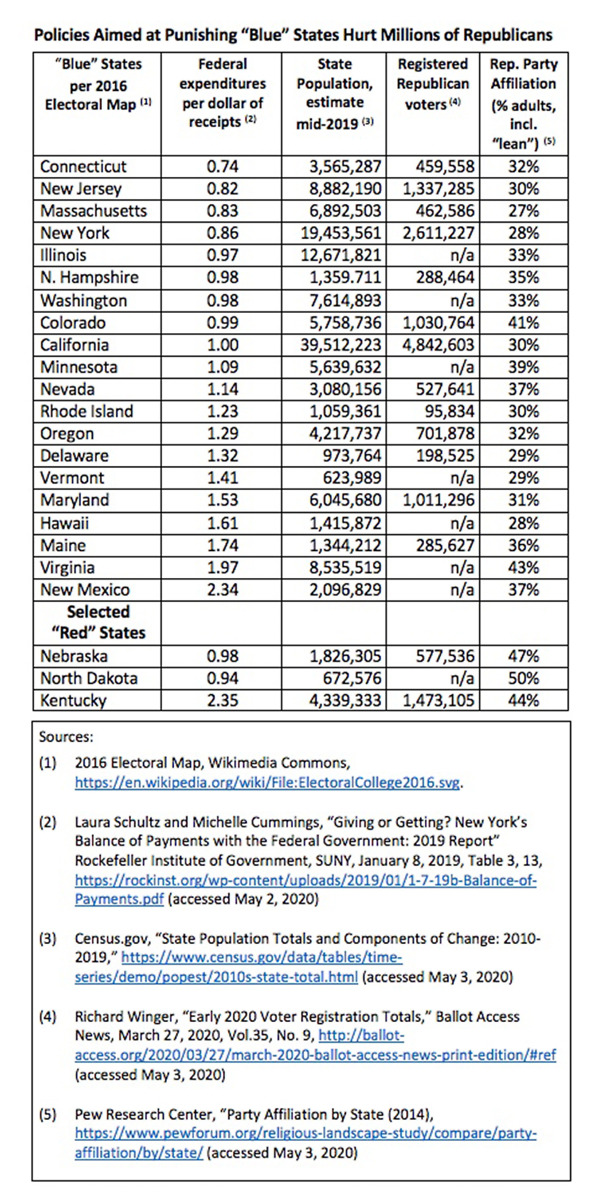“Blue-state bailouts.” That’s what Mitch McConnell (R-Ky) in late April called federal aid for state budgets hit hard by the coronavirus pandemic. Instead, he suggested bankruptcy. Bipartisan blowback was swift.
Gov. Andrew Cuomo (D-NY) rightly pronounced such rhetoric “dumb” and called out Kentucky’s heavy reliance on federal subsidies. Unfortunately, politicizing disaster relief is not only dumb, it’s unfair, and in this case, dangerous.
Donald Trump, ever eager for a partisan fight, appears ready to double down on McConnell’s gambit. He proposes tying Covid-19 aid to political concessions he’d like to extract, as if states were hostile foreign nations.
Given the mounting death toll and economic hardship facing so many states, it’s depressing to see federal help ransomed in such a nakedly partisan fashion. But it isn’t surprising. We’ve seen this movie before, following hurricanes. Trump’s political math employs a standard order of operations: He begins with division, then multiplies chaos, adds blame and self-flattery, and subtracts from the mess whatever personal gain he can.
What I wonder, though, is how Republicans who live in “blue” states feel about being casually written off as collateral damage in this tribal warfare. GOP leaders talk as if only Democrats live in “blue” states. That’s obviously wrong. How many Republican taxpayers are they ignoring?
I decided to find out and created the table that appears below. The results surprised me; they may surprise you, as well.
About the “blue” (and “red”) state numbers
Gathering the needed data was more difficult than I expected. It required making an initial assumption, and then accepting the limitations of figures and estimates published by four separate sources in different years.
Column 1
First, is the issue of what makes a state “blue.” I assumed that McConnell and Trump mean states where 2016 Electoral College votes went to Hillary Clinton. Whether all of them are still “blue” is unknowable (until November). For reference, here is the 2016 Electoral Map. These “blue” states (excluding the District of Columbia) are listed in the first column of my table.
2016 “Blue” States

Column 2
Next, I wanted to see whether these “blue” states are “givers or takers.” Are they sending more taxes to Washington than they get back in federal spending? Or do they get back more than they send in?
In 2011, the Census Bureau stopped publishing its “Consolidated Federal Funds Report” that detailed spending by state. That forced nongovernment researchers to crunch more numbers to compare the flows of money between states and the federal government. The Rockefeller Institute at the State University of New York has boiled these balance of payments into a single figure that’s easy to understand.
If a state gets back the same federal spending as its residents pay in federal taxes, its figure is 1.00. If a state gets back more federal spending than it pays in taxes, the number is higher—making it a “taker.” If state gets back less than it sends to Washington, D.C., its number is below 1.00—meaning it’s a “giver.” These figures are found in the second column.
Column 3
The Census Bureau updates its population estimates regularly, but we are a decade beyond the last official count and a year away from results of the census underway. Let’s assume the figures in the third column, drawn from “State Population Totals and Components of Change: 2010-2019,” are the best available.
Column 4
Voter registration records should be an easy way to tally the Republicans in “blue” states—if every state registered its voters by party. However, only 31 states require voters to register party affiliation. That’s why “n/a” (not available) appears for eight states in the fourth column. I found a current list of the 31 state registrations at Ballot Access News.
Column 5
The fifth column is an attempt to make informed guesses about those missing registration numbers. The Pew Research Center used public surveys to estimate the party affiliation of adults in each state. These figures include both those officially registered and those who “lean” toward a particular party.

The findings
- Let’s start with the observation that these 20 “blue” states are fewer than half of our 50 states, but their combined 140.7 million people represent 43 percent of the nation’s estimated 2019 population of 328,239,523. For that reason alone, dismissing their budget concerns is, politically speaking, dumb, and financially speaking, dangerous.
- Among our 50 states, only 10 pay in more federal taxes than they get back in federal spending. Eight are “blue.” At the bottom of the table, I’ve added the two “red” states, Nebraska and North Dakota, that are among the “givers.” All the rest are “takers,” and I’ve included the state that receives the most federal spending relative to its share federal of taxes. That would be Kentucky, McConnell’s home state, which gets back $2.35 for every $1 it sends to Washington.
- Eyeballing the column of “blue” states’ federal spending per dollar of tax receipts against the population column, there does not appear to be any obvious correlation among population, geographic size or location and a state’s status as a “giver” or “taker.”
- There are more registered Republicans in Kentucky, which gets $2.35 back for every $1 sent to the federal government, than the entire population of New Hampshire, which gets only 98 cents back for every dollar.
- There are more registered Republicans in California alone than the individual total populations of nine other “blue” states.
The takeaway
Ultimately, the lack of complete voter registration data means I cannot definitively answer my original question: How many Republican taxpayers are they ignoring?
But the figures show that the 13.85 million registered Republicans in 13 “blue” states that record party affiliation are more than the entire populations of all but four states (California, Florida, New York and Texas). Extrapolating the 28 to 43 percent of adults who at least lean Republican in the non-registering states adds millions more.
So, it’s clear that when national GOP leaders target “blue” states for political mischief, their tactics will ultimately hurt what amounts to a large state of Republicans.
Whenever you hear politicians on TV posturing against “blue” (or “red”) states, remember that every state is a mix of people with different political viewpoints. Every taxpayer deserves equal treatment by the federal government, and that includes equal treatment of the states that make up our federal system.





